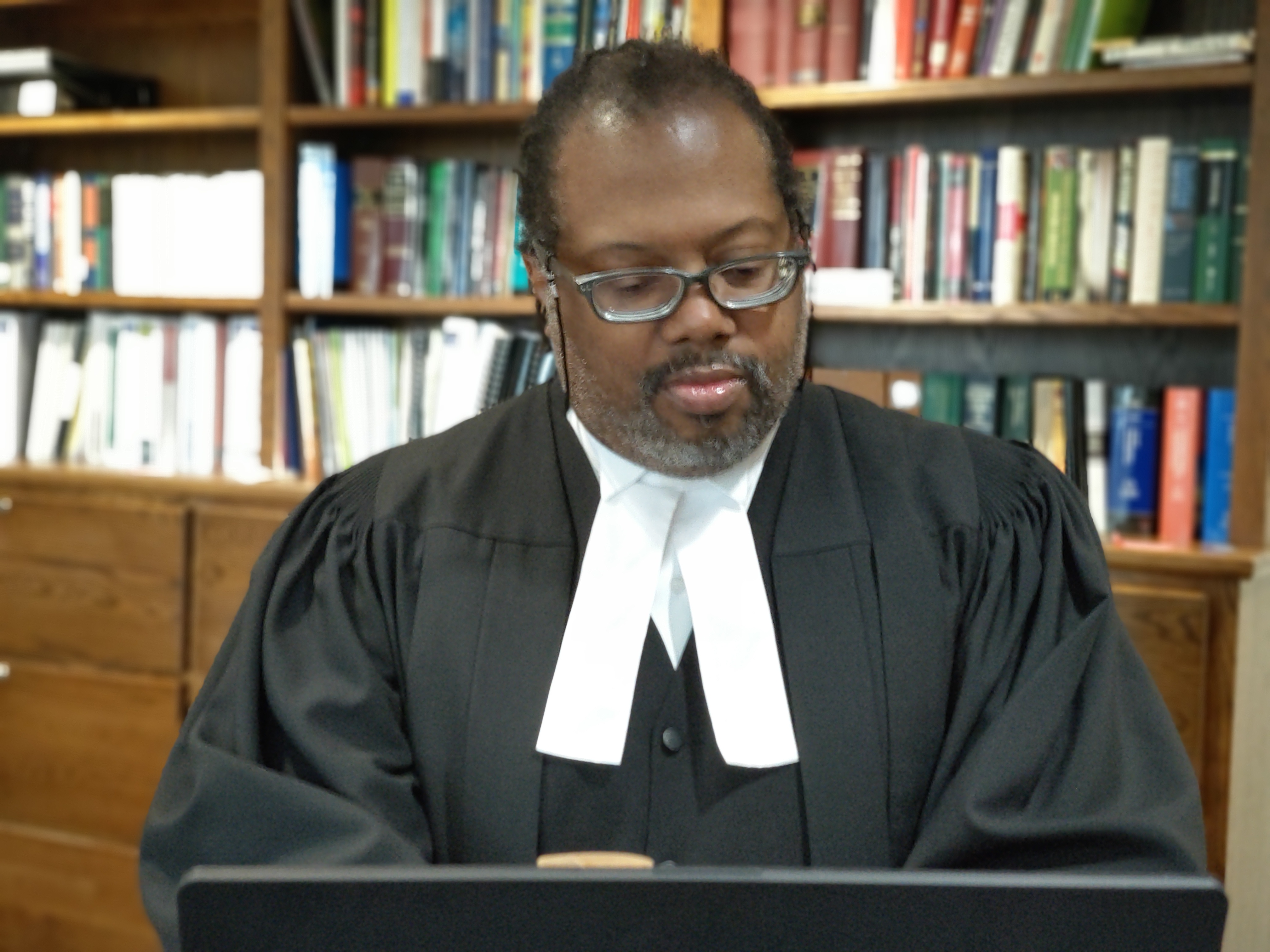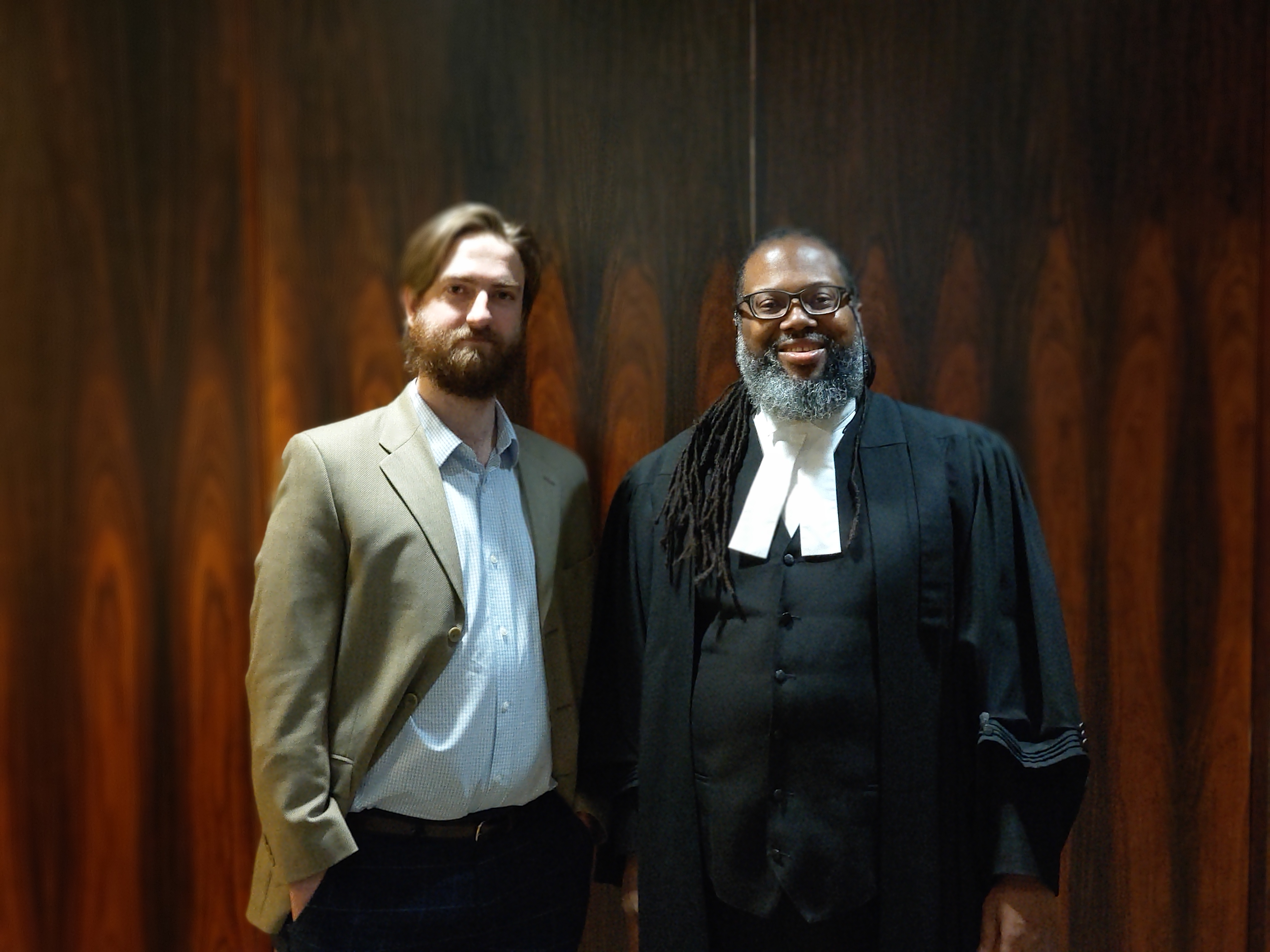




Practice Areas
Selwyn A. Pieters, Barrister & Solicitor, is a progressive sole practitioner law firm committed to providing the highest quality legal services in a respectful and supportive environment.
Selwyn Pieters has extensive legal experience in a number of areas including Human Rights Law, Criminal Law, Employment Law, Administrative Law, Immigration Law, Civil Liberties Litigation, Constitutional Law and Alternative Dispute Resolution. As can be seen from the hundreds of reported cases on a wide area of law, Selwyn has extensive trial work at both the provincial and supreme court levels, appellate experience at the Federal Court of Appeal, Ontario Court of Appeal and Supreme Court of Canada, Administrative Law experience at numerous administrative tribunal and significant experience working with youth including homeless, marginalized, gay, racialized and Black youth. Selwyn is also sought out by leaders and rank and file officers in law enforcement (Police and Corrections), the teaching profession, business, public servants, non-profit organizations and politics (federal, provincial and municipal).
Case Examples
.
1) R. v. Roach [2005] O.J. No. 5278 (On. CJ). Atiba Roach, a 24 year old Black Male, attended the entertainment District in Toronto to celebrate his birthday with friends. There was some form of disturbance in the area that Mr. Roach and his friends were not, yet he was arrested and charged with causing a disturbance. During the arrest he was pepper sprayed by police. None of that was contained in the notes of the arresting officer. His mother, a psychologist, had the presence of mind to keep the clothing her son was wearing in a sealed, air tight plastic bag. In reading the officer's notes it was evident to me that this was a case in which stereotypical assumptions determined the actions that the police took to stop, pepper spray, detain and attempt to criminalized Mr. Roach. I requested the disclosure to properly defend Mr. Roach and the police and crown failed to provide the requisite disclosure. I was able to demolish the Crown's witness on cross-examination and the findings of the judge was significant and a boost of confidence to me as a fist year criminal lawyer:
¶ 33 After more than a year the shirt, with the orange dye clearly showing on it, was plainly evident to contain a noxious substance of some kind, which caused an immediate allergic reaction in the court, both for Mrs. Roach who was on the witness stand at the time and from the Court Reporter.
¶ 34 I therefore have no question in my mind on this essential fact, that pepper spray was used that evening and that Mr. Roach was pepper sprayed.
¶ 35 I am also prepared to find as more troubling for me, as a Judge, the fact that Constable Blanchfield misled this Court.
¶
36 Constable Blanchfield, in my view, in his preparation of his notes, in his trial preparation in response to defence requests for information about the case and about the pepper spray and about the Use of Force Reports, if they existed, and in his initial testimony before me, before he was cross-examined, did a remarkable imitation of the child parable of the three monkeys, hear no evil, see no evil, speak no evil.
This case was not only significant to Mr. Atiba Roach but it also revealed the extent to which police officers can sometimes engage in conduct that can mislead a court and cause a miscarriage of justice but for the able and zealous advocacy of defence counsel.
1a) City of Toronto et al v. Ontario (Attorney General), 2018 ONSC 5151 The Ontario Superior Court of Justice overturned Bill 5 – the so-called Better Local Government Act. Selwyn represented the applicant Rocco Achampong.
2) Rudder (Litigation guardian of) v. Ontario Amateur Softball [2005] O.J. No. 3358 was litigated and decided six months after my call August 5, 2005. This was the case on a mixed race (Aboriginal and Black) 11-year-old baseball player who was subjected to racial slurs from the Coach of the Stone Mills Stingers. The Ontario Amateur Softball Association (OASA) refused to release him. Mr. Rudder had become very distressed at the prospect that he would be denied the opportunity to participate in the last softball game of the year in his league. Upon reviewing the case I was unclear how the Softball Association considered its policies, instruction and guidelines in reaching the decision in question. Having regard to the racist slurs that Mr. Rudder experienced from the coach of his former team, it was apparent that he was now being made to shoulder the consequences of an unfair and discriminatory application of the rules governing transfer to another team. It appears to me that the urgent intervention of the Court was the option to best resolve this to Mr. Rudder’s benefit.
An application for an injunction had to be filed immediately. I was able to file the application on August 05, 2005, argue and got the injunction that put a stop to the decision of the ASSA. Justice Fran P. Kiteley found that prohibiting a star 11-year-old baseball player who loved the game from playing for the Kingston Kobras in the last tournament of the season would constitute irreparable harm. The successful; outcome of the case for the child made the news nationally and internationally: Boy allowed to switch teams after alleged slur CTV, August 05, 2005, Junior softball player allowed to switch teams after racial slur by coach Canadian Press, August 05, 2005: reported at: Examiner. Barrie, Ont.: Aug 6, 2005. p. A.6.Fro; Kingston Whig - Standard. Kingston, Ont.: Aug 6, 2005. p. 1.Front ; Moose Jaw Times Herald. Moose Jaw, Sask.: Aug 6, 2005. p. 8; Standard - Freeholder. Cornwall, Ont.: Aug 6, 2005. p. 7; Sudbury Star. Sudbury, Ont.: Aug 6, 2005. p. A.7; The Intelligencer. Belleville, Ont.: Aug 6, 2005. p. A.4; The Record. Kitchener, Ont.: Aug 6, 2005. p. A.4; The Spectator. Hamilton, Ont.: Aug 6, 2005. p. A.13; The Windsor Star. Windsor, Ont.: Aug 6, 2005. p. A.11; Times - Colonist. Victoria, B.C.: Aug 6, 2005. p. A.7, Court lets pitcher, 11, stay on his new team Globe and Mail, August 6, 2005, p. A2. Mr. Rudder case was a significant public interest case that was done pro-bono. This case remains significant because I was able to bring a time sensitive issue to the attention of the Court and obtain a favorable result
3) M. (R.) was a case involving a youth 14 years old who was arrested four time by Toronto Police all based on racial profiling and improperly targeted him for arrest and detention based on Code-related grounds. He has no convictions yet was targetted, carded, arrested, detained, on several occasions. His case was fiercely litigated by Toronto Police and the reported decisions stand as a monument to the challenges litigants face in litigating racial profiling: See, M. (R.) v. Toronto Police Services Board, 2013 CarswellOnt 12134, 2013 HRTO 1472; M. (R.) v. Toronto Police Services Board, 2013 CarswellOnt 11941; M. (R.) v. Toronto Police Services Board, 2013 HRTO 1102 M. (R.) v. Toronto Police Services Board, 2013 HRTO 73; M. (R.) v. Toronto Police Services Board, 2012 CarswellOnt 11158; M. (R.) v. Toronto Police Services Board, [2011] O.H.R.T.D. No. 618, 2011 HRTO 410; M. (R.) v. Toronto Police Services Board, 2011 ONCJ 143, 2011 CarswellOnt 1980, 2011 ONCJ 143, 274 C.C.C. (3d) 272 (Ont. CJ.); M. (R.) v. Toronto Police Services Board, 2010 CarswellOnt 9121, 2010 HRTO 2349. M. (R.) v. Toronto Police Services Board was settled to the satisfaction of all parties and the terms of settlement reached remain confidential. My approach was to ensure M. (R) was competently represented despite his lack of financial resources. I saw this case as a test of the significant challenges young people faced in Toronto. Carding was a big issue and legislative changes was brought in in 2015 to end carding as it was. Mr. Justice Tulloch is now conducting a review of the carding regulation to determine it efficacy. I was privately consulted by both Attorney General Naqvi (and his staff) and Mr. Justice Michael Tulloch on the carding issue.
3(a) Featherstone v. Dufferin-Peel Catholic District School Board [2005] O.J. No. 4431 involved a Black teen who was suspended for 20 days pending expulsion for stealing a bag of chips and a pop at his High School. My aim was to get Mr. Featherstone back in school immediately. He had received a scholarship to study in the United States at Ohio State University and suspension and expulsion would have put the brakes on his further education. I successful brought an application in the Superior Court staying the suspension of Mr. Featherstone. This case was a textbook example of the harsh nature of the Education Act that was disproportionately affective Black students. In the end, this case was not only significant in the court to the student but prompted public debate which resulted in changes to the Education Act to consider mitigating circumstances and to use less punitive options to suspensions and expulsions for minor infractions: Global Television Report on the October 31, 2005 Press Conference to Scrap the Safe Schools Act, by Sean Mallen, October 31, 2005. Appealing for Justice, PULSE24.COM, October 31, 2005. Question Period, Legislative Assembly of Ontario, Hansard, October 31, 2005. Zero-tolerance school rules hit, London Free Press, Canada, October 31, 2005. Dufferin-Peel staff go to anti-racism school by Tess Kalinowski, Toronto Star, October 08, 2005, A47. Teen's suspension ends after legal challenge by Paul Choi, Globe and Mail, October 06, 2005, A15. "Back to Class for Teen" by Ian Robertson, Toronto Sun, October 06, 2005, B1. "Reinstated teen drops court case" by Tess Kalinowski, Toronto Star, October 06, 2005.
4) R. v. Steele 2006 CarswellOnt 7994 (SCJ). Mr. Richard Steele, a Black teenager, was part of a very massive trial in Toronto, Project GreenApple involving the murder of Jane Creba on December 26, 2005 on Yonge Street close to the Eaton Centre in Toronto. The media had an interest in the case and the Crown at the last minute sought a publication ban. Press Freedom is an important aspect of the Charter balanced with Trial fairness. I opposed the publication ban. Justice Grossi agreed with my arguments and wrote "I am of the view that what is happening here, if it is publicized, would not affect the fairness of the trial of this accused nor the fairness of the trial of those charged in the Jane Creba murder. In the end I do not accede to the Crown's request. Therefore there will be no publication ban." The headline the next day were Inside the hunt for the Boxing Day killer, Calgary Sun, 7 December 2006 and Wiretap manhunt, Toronto Sun, 7 December 2006. The Steele case was another important test of my ability as a young lawyer . I had to manage a significant amount of moving parts including the media, my Courtroom obligations, Mr. Steele's family, his prison conditions and the public and their perception given the high profile nature of the case. My work with this client generated a significant amount of reported decisions: R. v. Steele 2008 CarswellOnt 1221 (Ont. CJ.); R. v. Steele 2008 CarswellOnt 1215 (Ont. CJ.); R. v. Steele 2007 CarswellOnt 3011 (SCJ); R. v. Steele 2007 CarswellOnt 3045 (SCJ); R. v. Steele 2007 CarswellOnt 1193 (SCJ); R. v. Steele 2006 CarswellOnt 8492 (SCJ). Steele v. Ontario (Community Safety and Correctional Services), [2010] O.H.R.T.D. No. 1885, 2010 HRTO 1877 (CanLII), Steele v. Ontario (Minister of Community Safety and Correctional Services), 2010 HRTO 1428 (CanLII), Steele v. Ontario (Minister of Community Safety & Correctional Services); 2010 CarswellOnt 2943; 2010 HRTO 1019; Ontario Human Rights Tribunal; May 06, 2010.One of Mr. Steele's cases ended up at the Court of Appeal with leave refused at the Supreme Court of Canada: R. v. Steele 2015 CarswellOnt 3334, 2015 ONCA 169, [2015] O.J. No. 1253 (Ont. C.A.). Leave to the Supreme Court of Canada denied: R. v. Steele, 2015 CanLII 43092 (SCC) where an allegation of racial profiling was made against a Hamilton Police Officer. R. v. Steele, 2010 ONSC 233 (ON S.C.) was the original racial profiling arguments I made in Superior Court before a mistrial was declared.
5) Ms. Taylor-Baptiste was a manager at a Detention Centre in Toronto, who alleged she was subjected to discrimination on the basis of her sex in the workplace by a male union president. A human rights complaint was filed in the matter. Taylor-Baptiste v. OPSEU is one of the more significant labour and employment law cases in 2015. It was argued at the Court of Appeal by Ranjan Agarwal. I argued the case at the Human Rights Tribunal and my colleague Ranjan Agarwal argued at the Divisional Court and the Court of Appeal. The Ontario Court of Appeal dismissed the appeal in in the case of Taylor-Baptiste v. Ontario Public Service Employees Union, 2015 ONCA 495 affirming Taylor-Baptiste v. Ontario Public Service Employees Union, 2014 ONSC 2169 (Div. Ct.) and Taylor-Baptiste v. Ontario Public Service Employees Union et al, 2014 ONSC 5218 (costs). Counsel at the Court of Appeal and Divisional Court was Ranjan Agarwal and Amanda McLaughlin of Bennet Jones. At the Human Rights Tribunal I represented Correctional Manager Mariann Taylor-Baptiste in the ground-breaking competing rights case of Taylor-Baptiste v. Ontario Public Service Employees Union, 2012 CarswellOnt 8965, 2012 HRTO 1393, 2012 C.L.L.C. 230-022 reconsideration denied in 2013 CarswellOnt 1033, 2013 HRTO 180, 2013 C.L.L.C. 230-019 at the HRTO. The Supreme Court of Canada on an Application for Leave to Appeal denied leave Justices Abella, Karakatsanis and Brown.
The question of law decided by the Tribunal is whether the content of the blog posts violated the protections in section 5(1) and 5(2) of the Human Rights Code, R.S.O. 1990, c.H.19 (“the Code”) against discrimination with respect to employment and harassment in the workplace on the grounds of marital status and/or sex:
While the facts are straightforward, they raise difficult and challenging issues and conflicting interpretive values. In what circumstances are statements outside work hours, on line, “with respect to employment” or “in the workplace.”? In what circumstances, if any, can a manager make a Code claim against the Union or its leaders for statements directed at union members about the workplace relationship? The decision turned principally on undisputed facts and law.
The Tribunal applied a purposive and contextual interpretation of section 5 of the Code. The Tribunal found that the blog comments were not harassment ‘in the workplace’ under section 5(2), even given its broadest interpretation. This was because the posts ‘were made on a blog identified with the union that, although open to the public, was directed at communication between union members and their leadership.” In other words, the Tribunal is saying that for section 5(2) to apply to postings in cyberspace, there must be a sufficient nexus or connection. The Tribunal was less clear about what exactly would constitute a sufficient connection. In considering whether the respondent’s actions constituted discrimination under section 5(1) of the Code, the Tribunal deemed it necessary to consider all relevant circumstances, including: a. the seriousness of the conduct; b. their significance; c. their effect on the workplace; d. the role of the person making them; e. the effect on the applicant; and f. the reaction of the respondent to any concerns raised The Tribunal held that Mr. Dvorak’s comments were protected by the right to freedom of expression in section 2(b) of the Canadian Charter Rights and Freedoms and also the right to freedom of association in section 2(d) of the Charter. “This case involves an issue of competing rights” Ms. Taylor – Baptiste’s Code rights to freedom from discrimination with respect to employment and harassment in the workplace and the union’s core Charter rights to express themselves on matters of concern in the union-management relationship.”
Balancing the competing rights of the applicant and the respondent, the Tribunal assessed Mr. Dvorak’s rights against the appellants right to freedom from discrimination with respect to employment and harassment in the workplace: “The Tribunal has emphasized that ambiguity in the scope of Code rights should be resolved in favour of protecting matters at the core of Charter rights and freedoms.” The Tribunal disagreed that merely mentioning the applicant by name “as being the spouse of Mr. Gray, or as being the ex-spouse of Mr. Taylor-Baptiste” or simply raising concerns about nepotism without accompanying denigrating or humiliating comments, was sufficient to amount to discrimination on the basis of marital status.
The Tribunal was concerned about “the use of sexist language to convey the point of nepotism.” It found that the Respondent “drew upon frequently used sexist stereotypes about women in positions of power ‘sleeping their way to the top” through suggesting that her qualifications for the job was ‘intimate knowledge of another deputy.’” The Tribunal also found that the comment “if you don’t know the answers to something this simple you should call your boyfriend over at his office” draws upon the stereotype that women get ahead through their relationships with more competent ‘boyfriends.’” It found that the comment“ ...let Ms. Baptiste know that if she needs any help making a decision in the future, I’m sure he (the Applicant’s ex-husband) would help her. Maybe she should go back to her maiden name, or Gray, so as not to besmerch (read besmirch) the good ‘union’ name of Taylor-Baptiste” “also raised issues of sexism.” “Then Tribunal went on to find that “this issue and suggestion targets her as a woman because it was traditionally women who were expected to change their names upon marriage. This is an issue of gender and it singles her out as a woman.”
The Tribunal then observed that Mr. Dvorak failed to consider or address at that time the ways in which his posts could violate the Code or hurt individuals.”
Despite this, the Tribunal found that respondents did not discriminate against the applicant. The Tribunal assessed the following key factors to reach the decision:
1. Mr. Dvorak’s conduct as a Union President: as an active participant on behalf of the union in a process of restoration of a workplace that had been poisoned through racists hate mail; the Tribunal accepted the respondent’s evidence that the Mr. Dvorak had genuine concerns about nepotism and his comments were directed at union membership and related to the union-management relationship.
2. Frequency of the posts: the applicant was only mentioned once in the blog even though the blog was publicly accessible for a month; the tribunal also mentioned that the posts lost significance as more issues were raised.
3. Union comments on workplace issues are constitutionally protected expressions of opinion and exercise of freedom of association and the union’s right to operate independently of the employer. “Strong criticism from the union is often inherent in being a manager in a tense unionized workplace.”
Based on these factors, the Tribunal held that ‘while they [the blog posts] were relied upon sexist language, they were not gratuitous attacks unrelated to union business.” The Tribunal stated that the most important factor was the fact that “union comments on workplace issues are constitutionally protected expression of opinion and exercise of freedom of association, and close to the core of those rights.”
The Tribunal in weighing the competing rights in this case found that “most significant to my decision in this case are that the postings are tied to communications to the membership on issues of labour-management relations and the absence of Code-related effects in the workplace.”
As a result of these findings, the Tribunal found that the applicant was not harassed and not discriminated against by the Respondents and ordered that the Application be dismissed.
6) R. v. Aziga, 2008 CanLII 39222 (ON S.C.); R. v. Aziga; 2008 CarswellOnt 4300 (ON S.C.); R. v. Aziga, 2008 CanLII 29780 (ON S.C.). Johnson Aziga, a Black man, originally from Uganda, was charged with and convicted of two counts of first degree murder in connection with the deaths of two women who died of AIDS related complications after allegedly having unprotected sex with him. He was also charged with and convicted of eleven counts of aggravated sexual assault after allegedly failing to disclose his HIV positive status to his sexual partners, of whom seven became HIV positive. - This case was the first HIV/AIDS first degree murder trial in the world and it was very complicated. To compound a complicated case, Mr. Aziga was a very difficult person to deal with and his case posed significant challenges to the Court, the Crown and Defence Counsel. As a third year call I was able to managed the issues of whether Mr. Aziga should be shackled in the courtroom, important legal arguments on his conditions of confinement and whether they were compliant with sections 7 and 12 of the Charter and the only challenge for cause in Canada that deals with HIV-Phobia together with the intersection of race. Justice Lofchik agreed with the arguments I made on not shacking the accused in the courtroom. He also agreed with the challenge for cause arguments on HIV-Phobia and race. Justice Lofchik dismissed the section 12 constitutional arguments.
| Selwyn A. Pieters - Barrister & Solicitor; 2019 All rights reserved. |